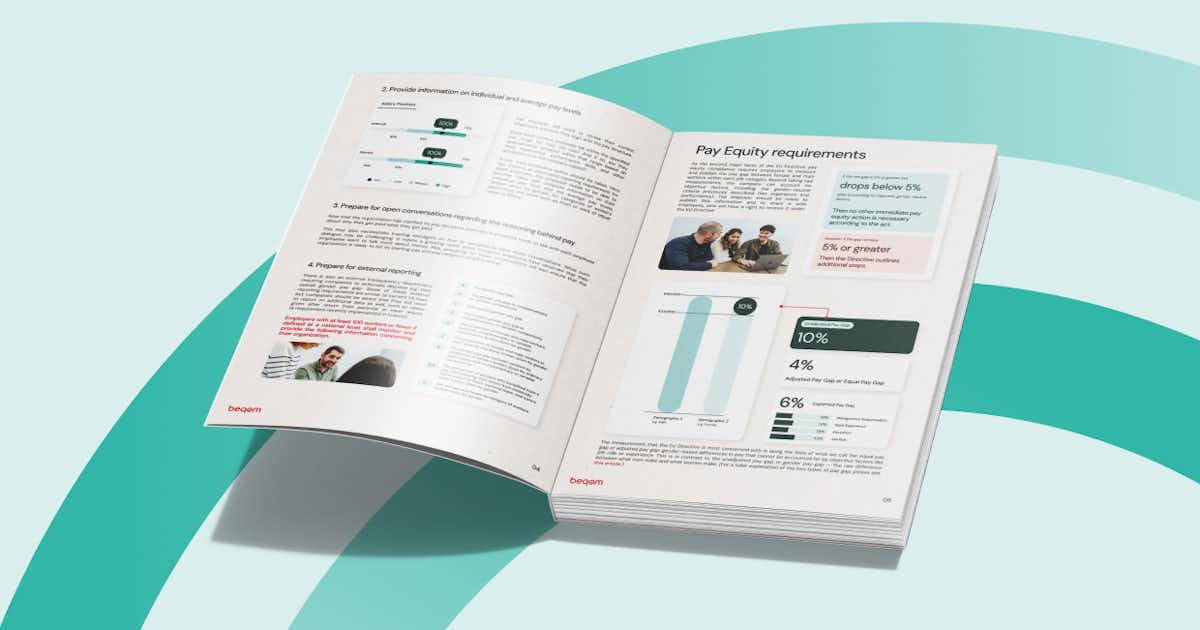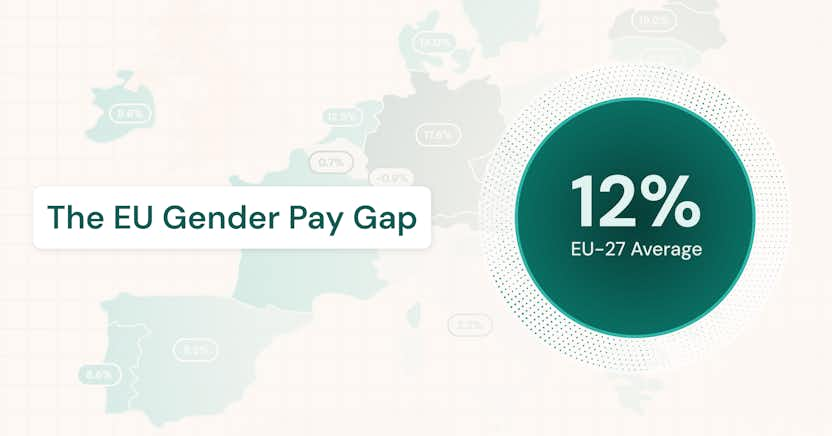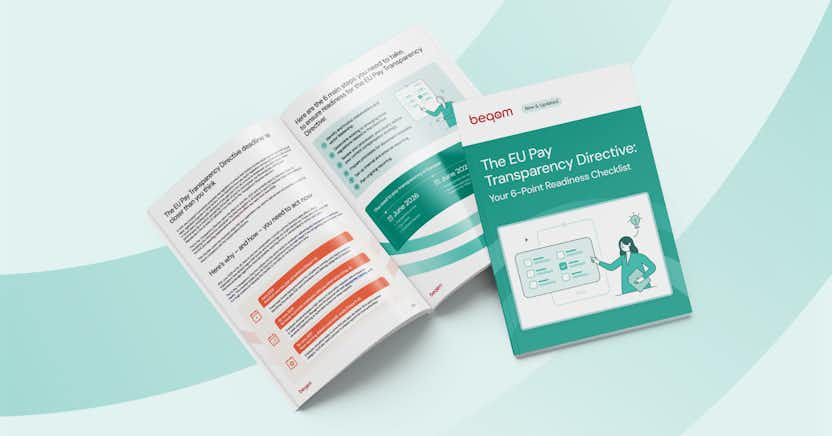The Time to Prepare is Now: EU Pay Transparency Directive Takes Hold in 2026

Learn more about the following beqom products
The EU Pay Transparency Directive 2023/970, which came into effect on June 6, 2023, aims to strengthen the principle of equal pay for equal work or work of equal value between men and women. Member states have until June 7, 2026, to implement the directive's provisions into their national legal systems. The first reporting cycle is expected to begin in 2027—meaning that now is the time for companies to start getting systems, policies, and procedures in place to ensure compliance and avoid fines and penalties. There really is just one comp round left before pay transparency becomes mandatory.
What is the impact on European and non-European organizations?
The Directive will compel European companies to increase transparency around pay structures, enforce measures to eliminate gender pay gaps and ensure compliance with stringent reporting requirements, ultimately fostering a more equitable workplace environment.
It likewise will influence US companies operating in the EU by requiring them to comply with stringent pay transparency and reporting standards, potentially driving similar expectations for transparency and equity in their domestic operations. This can lead to increased administrative efforts to ensure compliance and may prompt broader adoption of pay equity practices globally.
Companies should start preparing for compliance with the Directive as soon as possible. Early preparation will help companies adapt to new requirements, put systems in place, conduct necessary pay audits, and implement transparency measures to ensure smooth compliance.
This Directive introduces several key measures:
- Pay transparency: Employers must provide pay information to job applicants and current employees. This includes informing job applicants about the initial pay or its range before an interview and providing employees with information about their pay levels and the average pay levels for colleagues performing the same work, broken down by gender.
- Prohibition of pay history questions: Employers are prohibited from asking job applicants about their previous salaries, which helps prevent perpetuating pay disparities.
- Gender-neutral job evaluation: Pay structures must be based on objective, gender-neutral criteria to ensure fairness and eliminate direct or indirect discrimination.
- Reporting obligations: Companies with more than 100 employees must report on gender pay gaps and the proportion of men and women receiving different types of pay. If a gender pay gap of more than 5% is found and cannot be justified by objective factors, employers must take corrective actions.
- Enforcement and remedies: Employees have the right to request information on pay levels and take legal action if they believe there is pay discrimination. The directive also requires that employees who have experienced pay discrimination receive full compensation.
What are the benefits of compliance with the Directive?
Implementing the required practices under the EU Pay Transparency Directive can yield several benefits for companies:
- Enhanced employee trust and engagement: Transparency in pay fosters a culture of trust and fairness, leading to higher employee morale and engagement. When employees believe they are being compensated fairly, their job satisfaction and commitment to the company increase, potentially boosting productivity.
- Improved talent attraction and retention: Companies known for their fair and transparent pay practices are more attractive to top talent. This can enhance the company's reputation as an employer of choice, making it easier to attract and retain skilled employees in a competitive job market.
- Legal and regulatory compliance: By adhering to the directive, companies can avoid substantial fines and legal challenges associated with non-compliance. This not only mitigates financial risks but also safeguards the company’s reputation from the negative impacts of legal disputes.
- Diversity and inclusion: Implementing pay transparency measures can help identify and rectify gender and other demographic pay gaps, promoting a more diverse and inclusive workplace. This can lead to a variety of perspectives and ideas, driving innovation and better decision-making within the organization.
- Enhanced corporate reputation: Companies that proactively address pay equity and transparency are often viewed more favorably by stakeholders, including customers, investors, and the public. This positive perception can enhance the company’s brand and lead to increased business opportunities.
- Operational efficiency: Clear and structured pay policies can streamline compensation management processes, reducing administrative burdens and inconsistencies. This can lead to more efficient HR operations and better resource allocation.
By embracing the principles of pay transparency and equity, companies can create a fairer, more motivated, and ultimately more successful organization.
What are the penalties for non-compliance?
The Directive will impose significant penalties for non-compliance, including fines and compensation for affected employees. European companies that fail to meet the directive's requirements may face substantial financial penalties, reputational damage, and legal challenges. Non-European companies operating within the EU will also need to comply with these regulations, or they risk similar consequences. The exact penalties will vary by member state, but the directive mandates stringent enforcement mechanisms to ensure compliance.
How can companies prepare for the EU Pay Transparency Directive?
To prepare for compliance with the EU Pay Transparency Directive 2023/970, companies and HR compensation teams can take several proactive steps:
- Conduct a pay audit: Perform a thorough pay audit to identify any existing pay disparities within the organization. This involves analyzing pay data across different demographics (e.g., gender, race, job role) to pinpoint gaps.
- Implement transparent pay policies: Develop and implement clear, transparent pay policies that outline how pay is determined, including criteria for pay levels and progression. Ensure these policies are communicated effectively to all employees.
- Review and update job descriptions: Ensure that job descriptions and titles are gender-neutral and accurately reflect the responsibilities and requirements of each role. This helps in making objective pay comparisons.
- Train HR and management: Provide training for HR professionals and managers on the new requirements of the directive, focusing on non-discriminatory pay practices and how to address pay transparency with employees.
- Establish reporting mechanisms: Set up systems to regularly report pay data, including gender pay gaps and the proportion of men and women receiving different types of pay. Ensure that these reports are easily accessible to employees and comply with the directive's requirements.
- Prepare for pay transparency requests: Create processes for handling employee requests for pay information, including their individual pay levels and average pay levels for colleagues performing similar work. Ensure that these processes are efficient and protect employee confidentiality.
- Engage with employee representatives: Collaborate with employee representatives to identify, remedy, and prevent discriminatory pay practices. This involves working together to address any identified gender pay gaps and implementing corrective measures.
- Utilize analytical tools: Invest in analytical tools and methodologies to assess and compare the value of different jobs objectively and gender-neutrally. This will help ensure that pay structures are free from discrimination.
- Communicate changes: Keep employees informed about the changes being implemented to comply with the directive. Regular communication can help build trust and demonstrate the company's commitment to fair pay practices.
- Plan for long-term compliance: Develop a long-term pay equity strategy to ensure ongoing compliance with the directive. This includes setting up periodic reviews of pay practices, continuous training programs, and staying updated with any additional regulatory changes.
By taking these steps, companies and HR compensation teams can effectively prepare for compliance with the EU Pay Transparency Directive, ensuring fair and transparent pay practices across their organizations.
How can technology help?
Dedicated pay equity software can be extremely beneficial for managing compliance with the EU Pay Transparency Directive 2023/970. Here’s how such software can help:
How dedicated pay equity software helps with compliance:
- Automated pay audits: Pay equity software automates the process of conducting regular pay audits, helping to identify any pay disparities across different demographic groups. This ensures that the company can quickly detect and address any potential issues related to pay discrimination.
- Data analysis and reporting: These tools provide advanced data analytics capabilities, enabling HR teams to generate detailed reports on pay structures, gender pay gaps, and other key metrics required by the directive. This facilitates the preparation and submission of required reports to regulatory bodies.
- Transparency and communication: Pay equity software helps organizations maintain transparency by providing employees with access to information about pay levels and criteria used to determine compensation. This can help companies meet the directive’s requirements for providing pay information to both prospective and current employees.
- Objective job evaluation: The software can assist in creating and maintaining gender-neutral job evaluation criteria, ensuring that all roles are assessed objectively. This helps eliminate any biases in pay structures and supports compliance with the directive’s requirements for non-discriminatory pay practices.
- Real-time monitoring and alerts: Pay equity software allows for real-time monitoring of pay practices and can alert HR teams to any discrepancies or emerging pay gaps. This proactive approach helps organizations address issues before they become compliance problems.
- Compliance tracking: The software can track changes in pay equity regulations and ensure that the organization remains compliant with the latest requirements. This is particularly useful given the evolving nature of pay equity laws and the need for ongoing compliance.
- Simplified data management: Managing large volumes of compensation data manually can be cumbersome and error-prone. Pay equity software centralizes and organizes this data, making it easier to manage and audit.
Benefits of using dedicated pay equity software:
- Efficiency: Automates complex processes, saving time and reducing the administrative burden on HR teams.
- Accuracy: Minimizes errors associated with manual data handling and ensures precise reporting.
- Consistency: Ensures consistent application of pay policies across the organization.
- Insight: Provides valuable insights into pay practices, helping to make informed decisions about compensation strategies.
- Proactivity: Enables a proactive approach to managing pay equity, helping to prevent issues before they arise.
Dedicated pay equity software offers significant advantages that can streamline compliance efforts, improve transparency, and support fair pay practices within the organization.
Purpose-built software: PayAnalytics by beqom
PayAnalytics by beqom is a robust tool designed to help companies manage pay equity and comply with regulations like the EU Pay Transparency Directive 2023/970. Here's how it can assist with compliance:
- Comprehensive pay equity analysis: PayAnalytics enables organizations to conduct detailed pay equity analyses, identifying gender and demographic pay discrepancies using advanced analytics. This helps in uncovering and addressing any unjustified pay gaps effectively.
- Automated reporting and compliance: The software offers built-in templates and customizable reports to meet global compliance requirements. This includes generating the necessary reports for transparency of salary ranges and benefits, which are essential for adhering to the EU directive.
- Remediation recommendations: PayAnalytics provides tailored recommendations to close identified pay gaps. This includes guidance on fair salary adjustments, ensuring that remediation actions are both effective and within budget constraints.
- Real-time monitoring and alerts: As an always-on pay equity solution, the platform continuously monitors compensation data, allowing companies to maintain up-to-date compliance with evolving regulations. It provides alerts on any emerging issues, enabling proactive management of pay equity.
- Integration with HR systems: PayAnalytics integrates seamlessly with existing HRIS and compensation management systems, making it easier to embed pay equity analysis and actions into everyday HR processes.
Overall, PayAnalytics by beqom offers a comprehensive solution for managing pay equity in a sustainable way, ensuring transparency, and complying with global regulatory requirements. Its advanced analytical capabilities, combined with real-time monitoring and integration features, make it a valuable tool for HR and compensation teams striving to maintain fair and equitable pay practices. For more information on how technology can help you comply with pay equity and transparency requirements, contact the experts at beqom.







